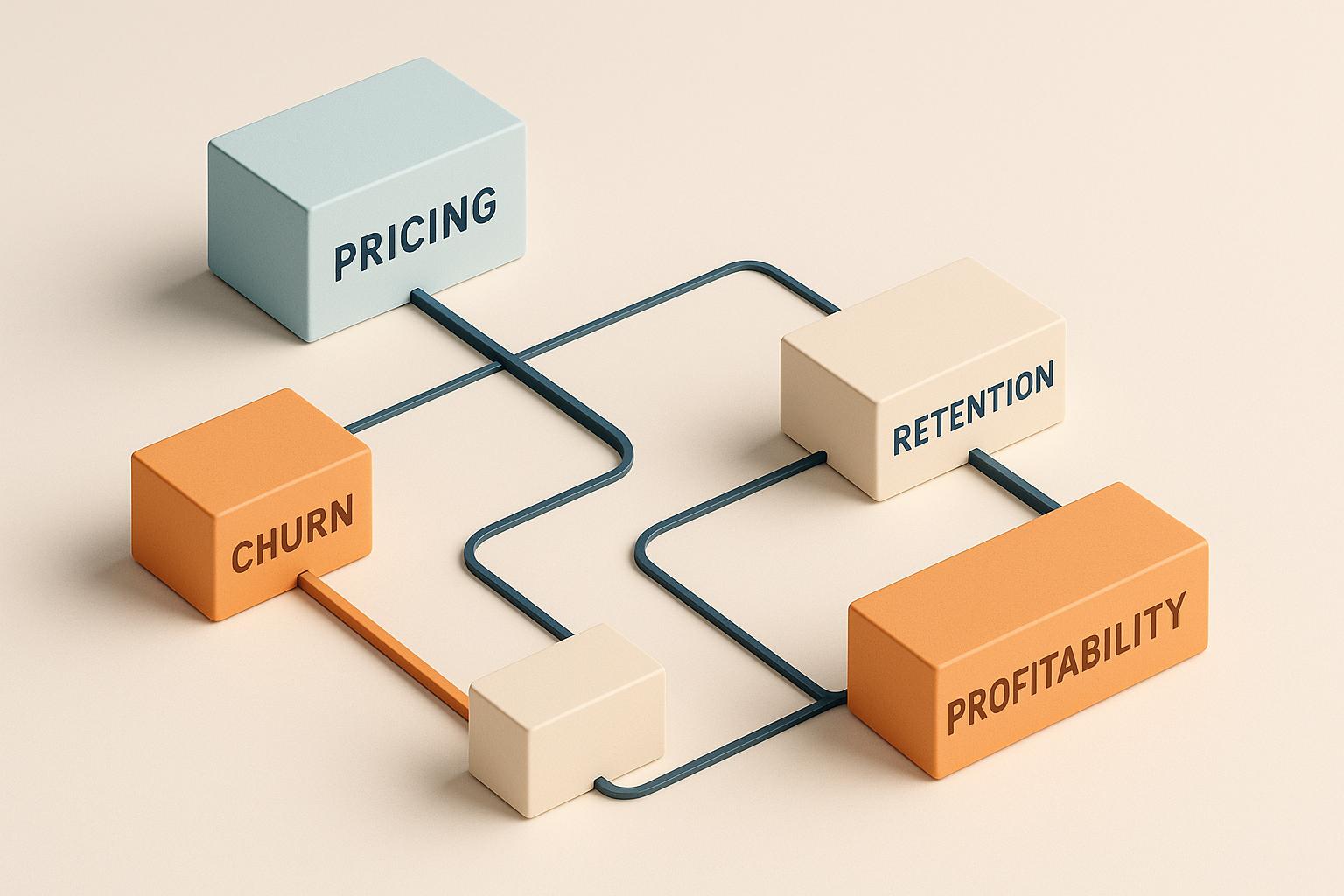Real Estate Data Analytics for Cash Flow Forecasting

Cash flow forecasting in commercial real estate (CRE) is the process of predicting the inflow and outflow of money for properties over time. Accurate forecasts are essential due to fluctuating rental income, tenant turnover, debt payments, and maintenance costs. With rising interest rates and changing property valuations, precision is even more critical today.
How data analytics improves forecasting:
- Machine learning identifies patterns and trends from historical and market data.
- Scenario modeling simulates outcomes like lease renewals or interest rate changes.
- Automation integrates real-time data from property systems and market reports.
Key benefits for investors:
- Better financial planning: Identify surplus cash for acquisitions or address shortfalls early.
- Risk management: Anticipate tenant vacancies and cash flow gaps.
- Build trust: Data-backed forecasts enhance credibility with lenders and investors.
Best practices include:
- Use internal data (rent rolls, accounting systems) and external reports (market trends, tools like Argus Enterprise).
- Validate data with automated tools and cross-checks to reduce errors.
- Combine historical data with projections for a complete view.
- Regularly update forecasts and test them under different scenarios (e.g., interest rate changes, tenant losses).
Tools and techniques:
- Modern platforms integrate APIs and cloud-based solutions for real-time updates.
- Advanced technologies like machine learning support stress-testing and scenario planning.
- Compare tools based on features like integration, ease of use, and cost.
For growth-stage CRE investors: Data-driven forecasting sharpens decision-making, improves liquidity management, and supports growth strategies. Consider leveraging financial advisory services to refine models, prepare for funding, or optimize portfolios.
Accurate forecasting isn’t just useful - it’s critical for managing today’s challenges and planning for future success.
Data Sources and Integration Methods
Key Data Sources for CRE Cash Flow Forecasting
Creating accurate cash flow forecasts for commercial real estate (CRE) requires pulling data from several key sources. Internal data like accounting systems provide details on rental income, operating expenses, debt service, and capital expenditures. Rent rolls offer insights into tenant details, lease terms, and expirations, while lease agreements reveal clauses, renewal options, and tenant allowances. To enhance these, external reports on market trends and third-party cash flow tools, such as Argus Enterprise, help model future scenarios. Loan documents, which outline debt terms, are also critical for understanding cash flow timing.
Market trend reports from platforms like CoStar, REIS, or local brokerage firms add valuable external benchmarks. These reports include metrics like rental rates, vacancy trends, and absorption rates, offering a broader context to validate your assumptions about market conditions.
Third-party cash flow tools, such as Argus Enterprise, allow for more advanced forecasting. These applications simulate complex scenarios and generate forward-looking projections, which can then be combined with historical accounting data for a more comprehensive analysis.
Loan documentation plays a crucial role in forecasting, detailing interest rates, payment schedules, maturity dates, and prepayment penalties. This information is especially important when modeling refinancing scenarios or assessing debt service coverage.
With these data sources in place, the next step is ensuring the information is collected and validated effectively.
Best Practices for Data Collection and Validation
Consistent and accurate data collection is the backbone of reliable forecasting. Monthly, dated data is essential for calculating metrics like internal rates of return (IRRs). Models should always incorporate the latest accounting results to avoid errors, and rent roll totals should be cross-checked against revenue entries to catch discrepancies. Automating these processes can significantly reduce errors and save time.
Automated data extraction tools are particularly useful here. These tools can pull data directly from property management systems, accounting software, and external providers, ensuring consistency and minimizing transcription mistakes.
To keep things organized, use a chart map. This tool categorizes general ledger accounts into clear groups, such as income and operating expenses, and applies consistent sign conventions (e.g., multipliers of 1 or -1). This ensures data remains uniform across different systems.
Routine audits are another critical practice. They help identify outliers, omissions, and formatting issues. Research from Aberdeen and IBM highlights that rolling forecasts can improve revenue accuracy by about 14% compared to static models, but only when the data is of high quality.
Once the data is validated, it’s time to merge historical figures with forecasts for a complete picture.
Combining Historical and Forecast Data
To align historical performance with projections, use key dates like Acquisition, Actuals Through, Forecast Start, and Disposition. These dates help ensure a smooth transition from past data to future projections. An Actual+Forecast DCF model with three modules - Actuals, Forecast, and Combined - can automate updates and track variances, making the process more efficient.
The Acquisition Date, Actuals Through Date, Forecast Start Date, and Disposition Date provide a structured timeline, ensuring there are no gaps or overlaps when transitioning between historical and forecasted data.
Input-driven models are a better choice than hard-coded spreadsheets for combining data sources. These models are dynamic, allowing for easier updates and reducing the risk of errors when new data becomes available. For example, a "Today Period Input" can act as a cutoff point for actuals and the starting point for forecasts, simplifying transitions.
Integrated cash flow models tie everything together by linking acquisition, operations, financing, and exit phases into a single framework. When you update one section, the changes flow through the entire model, maintaining consistency between historical trends and future projections.
The key is to maintain the original forecast as a baseline while layering in actual performance data. This approach not only helps track variances but also improves the accuracy of your forecasts over time, building more dependable models for future investments.
Tools and Techniques for CRE Cash Flow Forecasting
Overview of CRE Forecasting Tools
When it comes to cash flow forecasting in commercial real estate (CRE), the tools available can vary widely in their features and functionality. Some are built for detailed cash flow modeling and long-term planning, offering a full suite of capabilities. Others lean on more flexible, spreadsheet-based setups, ideal for customized analysis. The right choice often depends on factors like the size of your portfolio, the level of automation you require, and the complexity of your leases. In recent years, advancements in technology have added even more precision and efficiency to these tools.
Advanced Technologies Driving Better Forecasts
Modern forecasting methods now leverage cutting-edge technologies to provide sharper, more adaptable projections. For example, machine learning and automated scenario modeling analyze massive datasets to uncover trends and adjust assumptions as market dynamics shift. Tools that integrate data through APIs and cloud-based platforms ensure your forecasts stay current by pulling in real-time operational and market information. These technologies are also powerful for stress-testing, letting you simulate various scenarios to see how changes in factors like interest rates, occupancy rates, or rental growth could affect outcomes. These innovations make it easier to navigate uncertainty and plan with confidence.
Key Considerations for Comparing Tools
When comparing forecasting tools, focus on a few critical features: seamless data integration, advanced scenario modeling, user-friendly interfaces, and cost-effectiveness. It's important to weigh the tool's capabilities against its price to ensure it aligns with your forecasting goals. The best tools will not only streamline your forecasting process but also provide the insights you need to make informed decisions.
Best Practices for CRE Cash Flow Forecasting
Step-by-Step Guide to Building a Forecast
To start, map out your operating cash flows. Break down rental income streams, including base rent, percentage rent, and CAM (common area maintenance) recoveries. Be sure to include lease specifics such as escalation clauses, renewal options, and expiration dates. Adjust these figures for periodic rent increases and inflation to keep your forecast realistic.
Next, estimate operating expenses. Review historical data to project costs like property taxes, insurance, utilities, maintenance, and management fees. Factor in any anticipated changes. Don’t forget to include capital expenditures - like HVAC systems, roof repairs, or tenant improvements - to capture the full scope of costs.
For financing, account for debt service schedules, refinancing timelines, and any potential equity contributions. Use sensitivity analyses to understand how changes in interest rates might affect your numbers. Pay close attention to market trends for rental growth, vacancy rates, and cap rate adjustments to ensure your projections align with current conditions.
Model Assumptions and Regular Updates
Keep a detailed record of all your model’s assumptions, from vacancy rates and rental growth to expense escalations and capital expenditure timing. This documentation not only helps explain variances but also serves as a guide for updates when market conditions shift.
Set up a routine process for variance analysis. Compare actual results with your projections to spot deviations caused by unexpected events. When discrepancies arise, update your model promptly. This approach helps you identify patterns over time and fine-tune your assumptions where needed.
Make it a habit to update your forecast regularly - whether monthly, quarterly, or as market dynamics change. Incorporate new lease details, operational changes, and fresh market data. This ongoing refinement ensures your forecast stays accurate and dependable. With your assumptions clearly documented and consistently updated, you’re ready to test your forecast under different scenarios.
Stress-Testing and Scenario Analysis
Scenario planning is a key step in making your forecast resilient. Build multiple scenarios - such as a base case, an optimistic case, and a pessimistic case - to explore a range of possible outcomes. For the pessimistic scenario, consider factors like slower rental growth or unexpected capital expenditures.
Conduct interest rate sensitivity analyses to understand how rate changes could affect refinancing costs and property values. Assess tenant concentration risk by analyzing the potential impact of losing a significant portion of income. Don’t forget to factor in re-tenanting costs and potential vacancies when evaluating this risk.
Take it a step further by testing your model against broader economic downturns. Look back at how similar properties performed during past recessions, and use those insights to ensure you maintain sufficient cash reserves. This preparation can guide decisions on leverage and future property investments.
If you need expert help refining your CRE cash flow forecasts, consider reaching out to financial advisory services. For instance, Phoenix Strategy Group offers specialized guidance and advanced analytics to help growth-focused companies improve their forecasting models and adapt to changing market conditions.
sbb-itb-e766981
Financial Advisory and Advanced Analytics for CRE Investors
Benefits of Financial Advisory Services
Building on the importance of data-driven forecasting, professional financial advisory services bring a new level of precision to cash flow predictions. These services provide CRE firms with access to fractional CFO expertise and proven forecasting techniques - resources that many growing companies might not have in-house.
Strong Financial Planning & Analysis (FP&A) systems help standardize processes for collecting, validating, and reporting data. Instead of relying on error-prone spreadsheets, these systems create automated workflows and exception reporting. The result? A smoother forecasting process with improved accuracy.
Financial advisors also offer an unbiased review of assumptions, ensuring forecasts are both realistic and grounded. When paired with advanced analytics, these insights take forecasting to the next level.
Advanced Analytics and Scalable Financial Models
Data engineering plays a crucial role in automating system integration, while scalable financial models combine property-level cash flows with portfolio-wide metrics like IRR and NPV. Automated data pipelines eliminate the need for manual reconciliation by seamlessly connecting various systems.
These integrated models enable real-time updates, ensuring that forecasts reflect current operations and provide up-to-date financial reporting.
Scalable models also allow for detailed performance analysis - whether it’s by square foot, tenant type, or property segment. This granular view helps investors pinpoint which parts of a portfolio deliver the strongest returns and identify areas where operational improvements could significantly boost cash flow.
Preparing for Growth, Funding, and Exits
With scalable models in place, investors can confidently plan for growth and strategic exits. Financial models that undergo sensitivity analyses and stress testing become valuable tools for fundraising and due diligence, especially during mergers and acquisitions (M&A). These models include key metrics and scenarios that investors prioritize, such as variations in debt service coverage and cash flow performance under different economic conditions.
In M&A scenarios, potential buyers scrutinize every cash flow forecast assumption - from lease renewal probabilities to the timing of capital expenditures. Well-prepared models, backed by clear documentation and solid assumptions, can be pivotal during valuation and deal negotiations.
Phoenix Strategy Group specializes in helping growth-stage companies navigate these critical transitions. By combining detailed financial modeling with operational expertise, they assist firms in optimizing cash flow ahead of fundraising efforts, expansion, or exit strategies.
In addition to traditional modeling, their strategic support evaluates acquisition opportunities, refinancing options, and portfolio optimization strategies. This ensures that as CRE portfolios grow, the underlying financial systems and processes can scale effectively, keeping forecasts accurate and actionable.
Conclusion and Key Takeaways
Summary of Key Insights
Data analytics has transformed cash flow forecasting in commercial real estate (CRE) from an educated guess into a precise science. By integrating diverse data sources, firms can create sharper forecasts and react swiftly to market shifts. The most forward-thinking CRE companies combine historical data with predictive analytics, crafting forecasts that reflect both current realities and future market trends.
Modern tools now make dynamic scenario analysis and stress testing more accessible, giving investors a clearer picture of how their portfolios might perform under various economic conditions.
However, even with advanced analytics, expert guidance remains essential. Professional financial advisors bring critical expertise in areas like model validation, assumption testing, and strategic planning - skills that many growing CRE firms may not have in-house. The combination of cutting-edge technology and seasoned advisory services builds forecasts that investors can rely on for key decisions, whether they’re considering acquisitions, refinancing, or exits. This blend of insights and expertise lays the groundwork for actionable strategies.
Next Steps for CRE Investors
To put these insights into action, start by evaluating your current forecasting process. Look for gaps in data collection or areas where outdated models may be skewing your results. Many firms find that they’re missing crucial data points or relying on assumptions that no longer hold true. Integrating property-level data with portfolio-wide metrics can help create a more comprehensive view of your financial performance.
Invest in systems that can scale with your portfolio. What works for a small number of properties often becomes unmanageable as your holdings grow. Automation and real-time reporting capabilities are key features to look for in any new platform.
If your firm needs additional expertise, consider working with specialized financial advisors like Phoenix Strategy Group. They offer services tailored to growth-stage companies, including fractional CFO support, FP&A systems, and data engineering. Their experience in M&A advisory and fundraising can also be invaluable during strategic transitions or expansion phases.
Final Thoughts on Scaling with Data-Driven Forecasting
For successful CRE investors, accurate cash flow forecasting isn’t just a tool - it’s the foundation for making sound strategic decisions. Data-driven insights can help pinpoint underperforming assets, optimize resource allocation, and strategically time market moves.
As portfolios expand and markets grow more complex, the firms that thrive are those that can adapt their forecasts to shifting conditions with speed and precision. This adaptability stems from having strong data systems, reliable analytical methods, and expert support to navigate growth and exit strategies. Scalable forecasting isn’t just about managing today’s portfolio - it’s about building a foundation for future growth, securing funding, and executing successful exits.
The investment in advanced forecasting capabilities pays off by enabling smarter decisions and driving long-term success. In the world of CRE, reliable cash flow forecasting isn’t a luxury - it’s a necessity for sustainable growth.
FAQs
How does machine learning improve cash flow forecasting for commercial real estate?
How Machine Learning Enhances Cash Flow Forecasting in Commercial Real Estate
Machine learning is transforming how cash flow forecasting is handled in commercial real estate. By analyzing historical financial data, it can uncover patterns and trends that might otherwise go unnoticed. These models are built to process massive datasets, spot irregularities, and deliver sharper predictions for future cash inflows and outflows.
For property owners and investors, this means smarter decision-making, reduced financial uncertainty, and the ability to fine-tune strategies for sustained growth. Even in unpredictable or volatile markets, machine learning delivers a level of forecasting precision that traditional methods often struggle to match.
What are the advantages of using automated data extraction tools for cash flow forecasting, and how do they help reduce errors?
Automated data extraction tools simplify cash flow forecasting by improving precision, saving time, and cutting down on human errors. By taking over tasks like data entry and reconciliation, these tools reduce the chance of mistakes and speed up processes, leading to more reliable financial predictions.
On top of that, automation offers real-time access to payment data and works smoothly with ERP and banking systems. This enhances forecast accuracy, enabling businesses to make smarter financial decisions while freeing up time for more strategic planning.
Why is it essential to update and stress-test cash flow forecasts in a dynamic real estate market?
Keeping cash flow forecasts updated and putting them through stress tests is essential for navigating a market that's always in motion. By running through different scenarios - like changes in rental income, rising operational expenses, or shifts in property values - businesses can gauge their financial strength and pinpoint areas of concern.
This kind of preparation allows companies to make smarter decisions, manage cash reserves efficiently, and have backup plans ready for unforeseen hurdles. In the fast-changing real estate world, having precise and flexible forecasts not only supports liquidity but also helps secure financial stability for the long haul.




